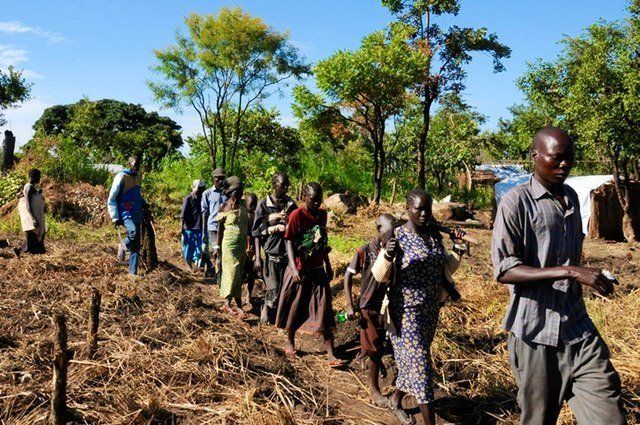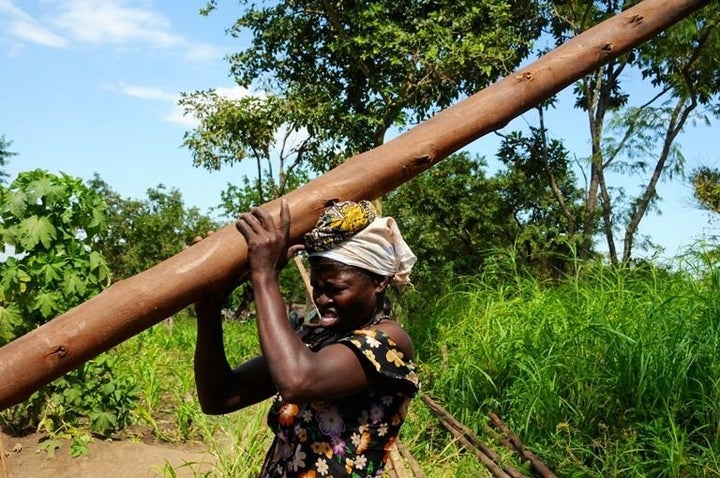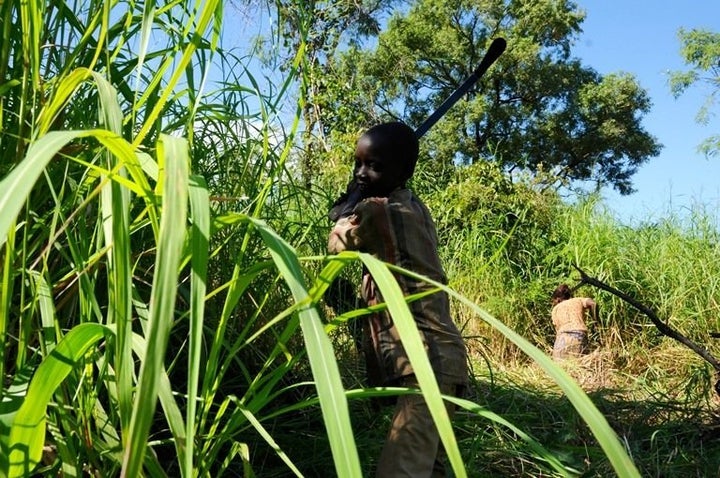
Uganda is celebrated around the world for providing refugees with the land and resources to become self-sufficient. But war in South Sudan is putting pressure on that model, leaving the most vulnerable struggling to survive, reports Carolyn Thompson from Uganda.
ADJUMANI, UGANDA – Michael Inyani pushes aside a thick tree branch with his scarred hand, wincing as he steps over a rock and onto his new property: a 100 feet by 100 feet (30 by 30 meter) plot of forest in northern Uganda.
Inyani fled from neighboring South Sudan in July after being mistaken for a rebel while going to pay his children’s school fees in the town of Nimule. The 30-year-old was arrested and beaten by a group of men in uniform, his arms tied behind his back while he was hit with sticks and rammed in the chest with guns.
He was released after the mistake was realized, but decided his family needed to leave the country. He, his wife, his two daughters and his son piled on to a small motorbike and drove from their hometown of Lao to the Ugandan border, about 22 miles (35 kilometers) away.
His family are now among more than 250,000 South Sudanese refugeeswho have flooded into Uganda since renewed clashes between government and opposition forces broke out in July. That is more than seven times the number who fled to Uganda during the entire first half of this year. By October, more than a million South Sudanese were displaced – with Uganda hosting the highest number by far.
The volume of arrivals has put pressure on Uganda’s celebrated approach to refugees. The country is recognized as a model around the world for its efforts to provide refugees with land, building supplies and resources to plant their own food.
Now, these resources are spread painfully thin. At several camps, refugees are being given rocky, sandy plots, with poor conditions for farming.
“At the moment the focus is on providing the immediate lifesaving assistance, and that has meant that some refugees have been provided with plots of land that are unsuitable for growing crops,” says Charlie Yaxley, spokesman for UNHCR, the U.N.’s refugee agency.
This is particularly challenging for sick or injured refugees, like Inyani, who was assigned a plot in Maaji refugee camp.

“I don’t know … whether I can work here,” Inyani says, looking around at the thick trees and bushes on the plot. He holds a sickle still wrapped in a light white tissue, along with a machete – tools provided to help the refugees clear their new land and construct shelter.
“Since I’m sick like this, the trees will be a problem for me,” he says, pulling up his shirt to reveal slashes of scars on his back. He carries a medical notebook with days of doctor visits scrawled inside, along with his prescriptions and details of his injuries: Swelling in the waist, evidence he was beaten.
With his injuries and his wife about to give birth to their fourth child, he doesn’t know how they’ll make do. Even fetching water and carrying it in a heavy jug is a struggle for the young couple. He had some help from fellow refugees, but still worries how he will manage.
The UNHCR and Ugandan government plans to eventually provide communal farm lands to refugees who received poor-quality plots.

For now, the scale of the crisis has shifted the priority to providing people with the basic means of survival.
In just two months, a 270-yard squared (250-meter squared) area in north Uganda has gone from a barren patch of land to one of the world’s biggest refugee camps called Bidibidi, hosting more than 150,000 refugees. The area lacks access to clean water, forcing the U.N. to truck it in – a costly and unsustainable approach.
“In a very short amount of time it’s become one of the largest refugee hosting areas in the world – and the numbers are growing,” Yaxley said of the Bidibidi camp. “New arrivals are coming in, and from what they say there are thousands more waiting to flee the country.”
In August, UNHCR, the Ugandan government and the World Food Programme announced they would cut rations in half for refugees who have been in the country for more than a year, in a drastic attempt to reallocate funds to the new arrivals. They have appealed for about $251 million to meet the needs of the refugees, but have received less than a third of that to date, Yaxley said.

“Now we are facing challenges. People are many. It is very difficult,” said Samuel Taban, chairman of the Maaji refugee settlement where Inyani lives.
Taban is distributing the plots, leading a group of about 50 people into the bush to assign uncleared sites. The cleared plots were distributed long ago.
The group steps over stones and roots, sometimes hacking a path forward with a machete. Some carry sleeping babies on their backs. Others walk slowly, weak from malnutrition or injuries, like Inyani.
“Really, we have suffered a lot,” Inyani says. He brought little with him from South Sudan, and much of his money was taken while he was crossing the border. He’s thankful to receive a plot, however impossible it might seem to cultivate, and is hopeful his young child will be born in a safe environment. Maybe, someday, if there is peace in his country, he will return.
But until then, he says he will keep struggling to survive.
Additional reporting by Lagu Joseph Lo-buga.
This article originally appeared on Refugees Deeply. For weekly updates and analysis about refugee issues, you can sign up to the Refugees Deeply email list.